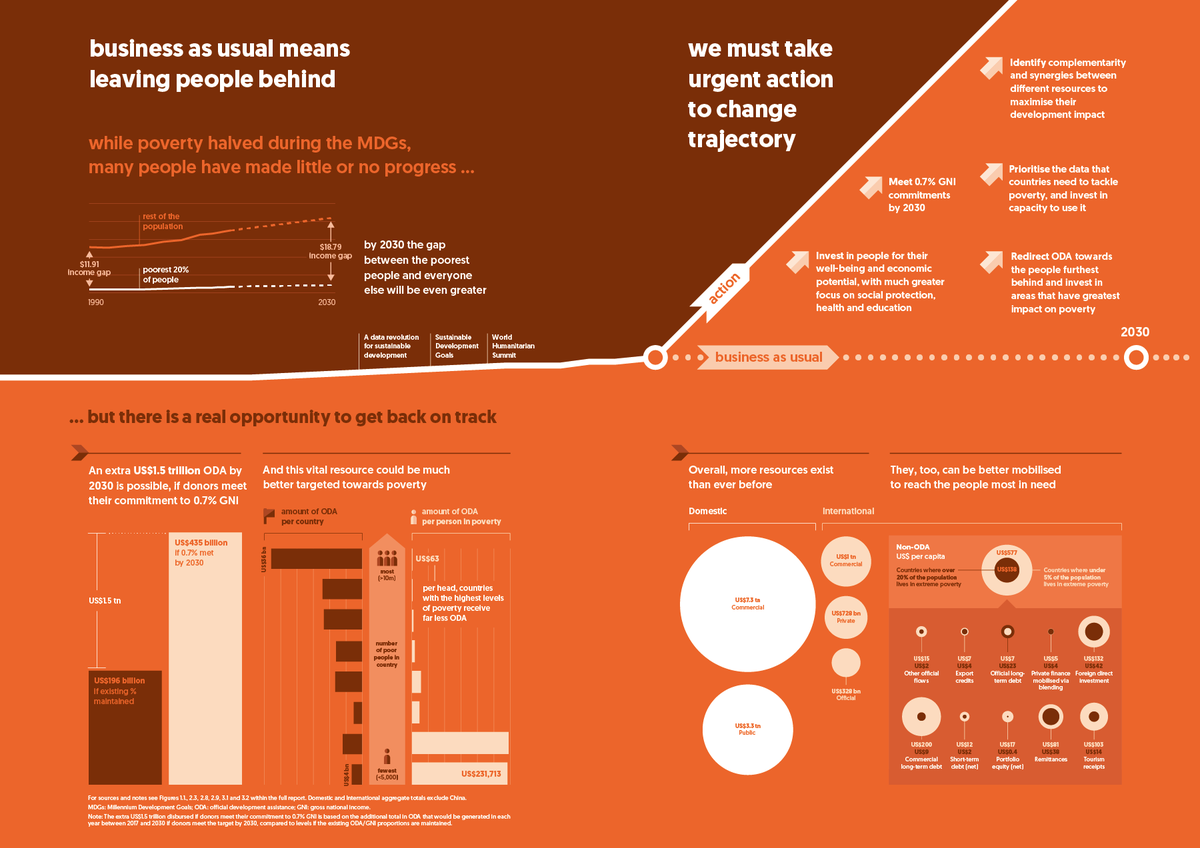Executive summary

While poverty halved during the MDGs, many people have made little or no progress but there is a real opportunity to get back on track.
For sources and notes see Figures 1.1, 2.3, 2.8, 2.9, 3.1 and 3.2 within the full report. Domestic and International aggregate totals exclude China.
MDGs: Millennium Development Goals; ODA: official development assistance; GNI: gross national income.
Note: The extra US$1.5 trillion disbursed if donors meet their commitment to 0.7% GNI is based on the additional total in ODA that would be generated in each year between 2017 and 2030 if donors meet the target by 2030, compared to levels if the existing ODA/GNI proportions are maintained.
Meeting the financing challenge to leave no one behind
The 2030 Agenda for Sustainable Development (Agenda 2030) sets an ambitious but achievable, universal and holistic agenda for all. There is a clear call for action to dramatically scale up development finance and improve the development impact of all financial flows. But it is at risk as the gap between the poorest people and the rest of the world widens.
- The poorest people are falling further and further behind everyone else as the income gap grows, consumption floors remain functionally stagnant for the poorest people and critical investment is not made in social protection and building human capital.
- In that context, official development assistance (ODA) continues to be the most critical source of external financing for development to support and complement national investments, particularly for the people and places most at risk of being left behind. Yet worrying trends show a shift away from a clear allocation to the people, countries and sectors most critical to ending poverty.
- All resources and all actors have a responsibility and a role to play, but investing to end poverty and closing the gap needs more than scaling up resources as many international resources increasingly bypass where they are needed most – in countries with high poverty rates and low domestic resource capacity.
- Information and data have not kept pace with the need for ever more disaggregated data to effectively identify the people and places most at risk and the resources available to them. And nor has investment and support for data use to target resources to the people furthest behind.
- All these factors mean that Agenda 2030 and its aspirational call to action are at risk – financing is only part of delivering sustainable development for all, but a necessary part. A future of business as usual will fail too many people, in too many places.
Investments to End Poverty 2018 explores how development finance is responding to this new and more challenging development and poverty landscape. It sets out an agenda to get back on track and ensure the promises the world has made to the poorest and most vulnerable people are met.
Action for Agenda 2030
Our agenda for action and key recommendations are as follows:
Invest in people
To end extreme poverty by 2030 and leave no one behind, the focus must be on people and on the poorest people first. That means increasing investment in human capital, including social protection schemes, health and education.
Close the widening gap to the poorest people
There is an urgent need to mobilise additional resources for the SDGs. All resources – international and domestic, public and private – have important roles and responsibilities, but for the poorest countries and people, ODA will remain vital. Donors therefore have a responsibility to ensure their ODA is being spent in line with the priorities of Agenda 2030. It is time for a refreshed vision of aid, recast as a resource to ensure no one is left behind. In support of that new vision:
- The volume of ODA should be increased in line with existing targets.
- ODA should be redirected to the people and places who need it most.
- The quantity, quality and development impact of other resource flows need to be improved.
- More effective approaches are needed in fragile contexts and crises to meet rapid and longer-term response needs.
Invest in data
Better data is required to target resources effectively to the people who need them most and, for each of those resources, to measure who is included and who is left out. That means greater investment in systems to ensure everyone is counted, and in the collection and use of data disaggregated by income, gender, geographic location, age and disability to identify the people at greatest risk of being left behind.
Political will and leadership are critical
Political will and leadership are critical
Despite limitations in data, who is at risk of being left behind and where they are, or will be, is broadly known. As are many of the types of investments, tools and mechanisms to best reach them. The allocation of resources is ultimately a political act, shaped by competing political incentives. How successfully these are overcome during the next decade will be measured by how many people remain in extreme and other dimensions of poverty, how many people remain excluded from progress and for how long the gap between the poorest and the rest continues to grow.